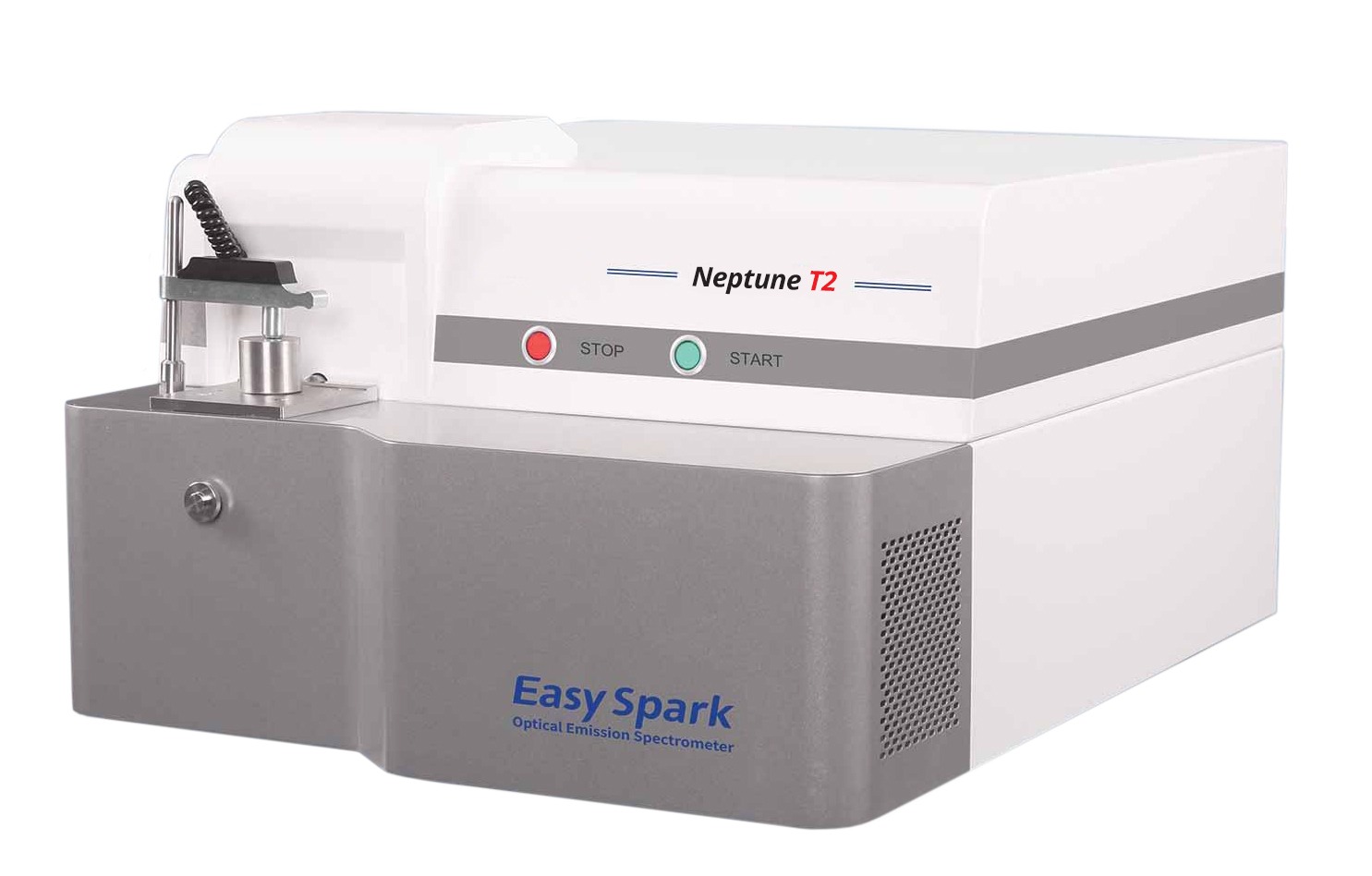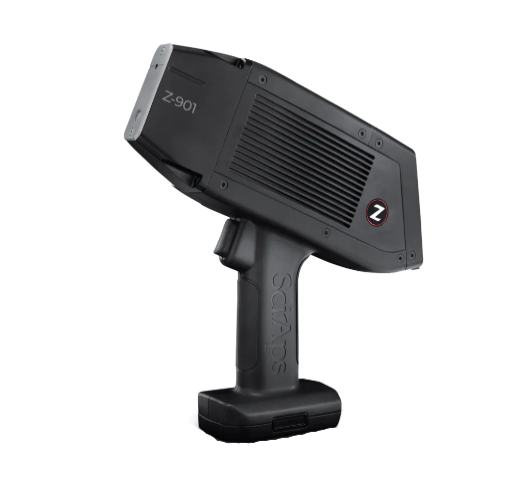
Z-901
Z-901 Series LIBS Analyzers
Z-901 Analyzer
The Z-901 features an all-new ergonomic design, a 0.5 lb. weight reduction down to about 3.5 lbs. (1.6 kg), improved heat dissipation, and completely updated software and processing electronics.
Z-901 Series LIBS Analyzers
| Model | Range (nm) | Best Application |
|---|---|---|
| Z-901 | 200 - 420 | General alloy testing for scrap sorting, PMI/NDT or quality assurance. Does not measure carbon. |
| Z-901 CSi | 190 - 260 | Analyzes carbon and silicon only. The perfect complement to your XRF. |
| Z-901 Li | 380 - 680 | Purpose built for lithium in soils, ores and rocks. |
| Z-901 Be | 200 - 420 | Purpose built for beryllium measurements, generally paired with XRF to cover all 13 EPA Priority Pollutant elements. Handheld XRF cannot measure Be. |
Factory calibrations do not include every element, but are provided for a set 15-20 elements depending on the application. Elements exclude unstable and radioactive elements. Detection limits vary greatly by element and sample type.
Z-901 CSi
Why the CSi?
Many operators own one or more XRFs for PMI/NDT. It’s their preferred tool for high temp alloys, and for elements contributing to carbon equivalents (CE), residuals, and stainless steel grades: V, Mn, Cr, Ni, Cu, Nb, Mo. However, XRF does not measure carbon and therefore no carbon equivalents, no separation of L- and H-grade stainless, nor can you use the more forgiving low RE formula (Ni + Cu) < 0.15%. The CSi is the perfect tool for operators who own XRF and need the occasional carbon measurement. It delivers fast, reliable carbon results to complement XRF tests, at a lower cost than the full LIBS system for carbon plus alloys. And SciAps cloud-driven data merging and report generation bring it all together in one report.
The CSi shows multiple carbon and silicon measurements, and the average. Meets multi-test averaging protocols required by some refineries and pipeline operators.
Our breakthrough LIBS technology is now widely accepted for carbon testing.
It’s included in API 578 2nd Edition, it’s accepted at most every major refinery, and in use worldwide by fabricators, pipeline owner/operators, power plants and other users of carbon steels and L- and H-grade stainless.
Cloud-Based Integration of XRF and CSi Data
Two analyzers means twice the reporting hassle, right? No. SciAps offers a cloud-based data merge and reporting tool so you can quickly merge CSi and XRF data to produce reports combining carbon and silicon from the LIBS with metals analysis from the XRF. Are you using a different XRF brand? No problem – ask your supplier for the data structure of their data export and we’ll incorporate it into our SciAps Cloud package. The data structure generally follows an industry standard and doesn’t involve proprietary software.
Z-901 Li
The world’s only handheld that analyzes lithium in rocks, ores, and powders.
In use globally for lithium exploration projects, with no travel restrictions or licensing headaches.
Exacting elemental analysis
- Factory calibrated for lithium in pegmatite, clays, and mica-schists, including relevant base elements in the 380 - 680 nm range.
- Microanalysis capability with 100 um laser spot size. On-board Y stage for rastering laser to discrete locations for targeted analysis or averaging.
- We also offers the Z-903, containing a third spectrometer to extend the analytical range down to 190 nm for users testing brines for other elements, including boron, magnesium, calcium, and potassium.
Engineered for field and lab
Our LIBS series handheld analyzers, at just 3.87 lbs. (1.75 kg) with battery, have an internal camera for precise targeting of analysis locations; a macro camera for photo-documentation of samples, reading bar codes and QR codes; a patented “sample sensor” that allows Class 1 operation (subject to LSO approval); high-resolution, rear-facing display for easy viewing; rugged metal body for maximum durability; a narrow snout for difficult-to-access test locations; and user-replaceable argon that provides hundreds of tests at pennies per test. Pair with Profile Builder software for PC or tablet and achieve full bench top functionality.
Intuitive operations
Android operating system and app-based software assure quality testing by every operator. Built-in Wi-Fi and Bluetooth, with GPS capability, allow users to print, email, and connect to virtually any information management system for real-time, full-featured reporting. Automatically merge XRF and LIBS tests with SciAps Cloud Services. Easily manage operations from anywhere.
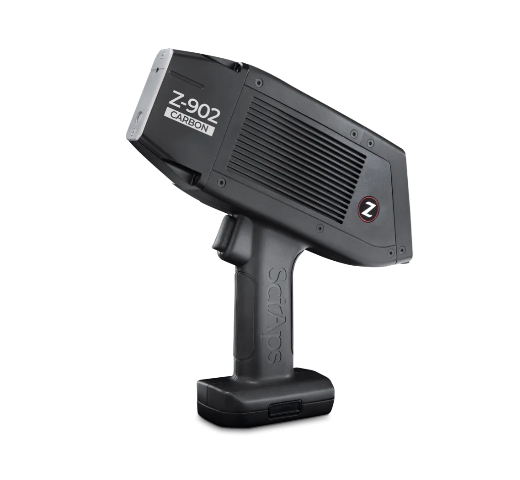
Z-902
Z-902 Analyzer
Z-902 Analyzer
The world’s first handheld analyzer to deliver carbon content just got better.
The Z-902 + features an all-new ergonomic design, a 0.5 lb. weight reduction down to about 3.5 lbs. (1.6 kg), improved heat dissipation, and completely updated software and processing electronics.
The Z-902 + can use on-board argon purge for high precision analysis or QuickSort for rapid material sorting or grade identification with air-burn. Depending on the element, the LIBS signal is 2x-10x higher when operating in argon purge versus air-burn.
The analyzer uses two spectrometers to extend the wavelength range to 190 – 620 nm. The instrument is factory calibrated for a suite of 15-20 elements, depending on application. Or operators may use the accompanying Profile Builder software package to customize to specific elements, their own calibration standards, and spectral processing. The Z-902 + can be set up to measure the emissions of any element. Common factory-calibrated Z-902 + applications include alloy and aluminum.
Alloy Analysis
Alloy: Argon-purge for high precision and improved detection limits. Many customers use argon-purge to analyze and sell mill-ready aluminum scrap.
QuickSort: Air-burn for rapid material sorting or grade identification.
The Z-902 + for alloy analysis measures 15-20 elements in 7 common alloy bases, including aluminum, stainless, iron, copper, titanium, nickel and cobalt bases. Other bases may be added for a small fee, or users may add their own calibrations.
Need to measure carbon in steels and stainless—including verifying L- and H-grade stainless? Use SciAps Z-902 Carbon, in use globally for measuring carbon and other elements in steels, stainless and nickel alloys.
Already own handheld XRF—and only need to add carbon measurements? Use Z-901 CSi, the ultra-compact analyzer that measures C and Si in steels, stainless.
Z-902 Carbon: A new industry standard
The key to rock solid, in-field carbon analysis for alloys.
- Identification of stainless steels and low alloy steels, including carbon analysis down to 70 ppm and instant CE (carbon equivalents) calculations.
- Powerful laser, on-board argon purge and high resolution spectrometer are built for carbon.
- Narrow profile for accessing the tightest spaces, aerospace-grade aluminum body for improved performance in high ambient temperatures, and re-designed user-interface. The most usable platform on the market, at only 4.35 lbs. (1.97 kg).
Spectrometer range 190 nm – 420 nm. Includes a second, dedicated spectrometer for superior resolution in the 190 – 230 nm range for carbon.
In use globally
PMI and NDT
Confirm alloy type and grade 300 series stainless steels into L, H, and S series. Carbon equivalent for welding. Material verification pre- and post-fabrication. Validating mill test reports. Material verification in chemical plants and refineries. Re-rating vessels.
Pipeline integrity management
Grading. Determining carbon equivalents. Validating MTRs.
Steel production
Screen incoming scrap material. In-process quality control. Resolving material mix-ups. Rapid screening of material at EAF for heat compliance.

Z-903
Z-903 Analyzer
Z-903 Analyzer
Every element in the periodic table, in seconds, in a handheld.
Bulk samples and micro-analysis
The Z is the world’s only handheld offering elemental micro-analysis in the field. Users may set up the raster to a grid pattern, using the 100 um laser spot size for elemental heat mapping point-by-point. For bulk samples, the Z can be set to average results from every raster location for a bulk sample result, just like handheld XRF analysis.
Australian Synchrotron’s X-ray fluorescence microprobe (XFM) data courtesy of Shaun Barker (University of Waikato) and Jeremy Vaughan (Barrick).
One analyzer, every element
The Z-903 accomplishes what no other portable analyzer has done. It’s a handheld analyzer that measures every element in the periodic table of the elements – from H to U.
It uses the same powerful laser as SciAps other Z-900 models, but with an extended spectrometer range from 190 nm out to 950 nm.
- The extended range allows emission lines from elements H, F, N, O, Br, Cl, Rb, Cs and S to be measured. These lines cannot be measured with the other Z-900 series analyzers.
- There are other benefits to the extended range. For example, it measures a more sensitive line for lithium near 675 nm to achieve limits of detection in the 2-5 ppm range.
- It also measures a more sensitive, and interference-free line for potassium (K). The more traditional potassium lines have heavy iron interference, whereas the line used by the Z-903 is free of such interference.
Z-903 Carbon: Extend the Range
The key to rock solid, in-field carbon analysis for alloys.
- Identification of stainless steels and low alloy steels, including carbon analysis down to 70 ppm and instant CE (carbon equivalents) calculations.
- Powerful laser, on-board argon purge and high resolution spectrometer are built for carbon.
- Narrow profile for accessing the tightest spaces, aerospace-grade aluminum body for improved performance in high ambient temperatures, and re-designed user-interface. The most usable platform on the market, at only 4.35 lbs. (1.97 kg).
Spectrometer range 190 nm – 625 nm. Includes a third, dedicated spectrometer for superior resolution.
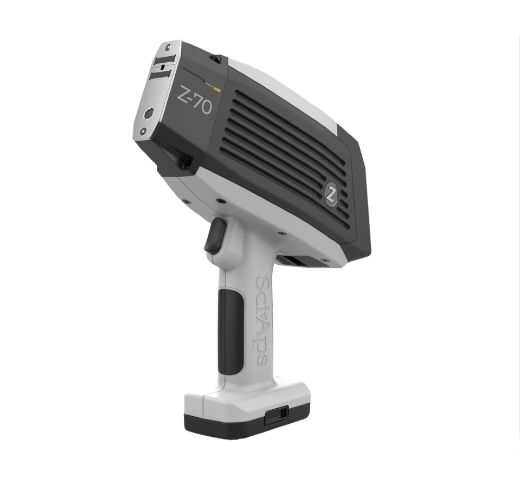
Z-70
Z-70 ALL NEW!
Z-70 ALL NEW!
Fast, Precise Metal Sorting Economical Handheld LIBS Minimal regulatory requirements
The Z-70 is a rugged handheld air-burn LIBS designed specifically for material ID testing. This new device brings the same industry leading technologies SciAps customers love into a pure sorting tool. The Z-70 is the easiest to use LIBS in the SciAps portfolio for material ID.
The Z-70 uses a 6 mJ/pulse laser which is the most powerful in the LIBS sorting market. Traditional material ID instruments use high repetition 150 μJ/pulse lasers that are too weak to properly clean dirty surfaces. This leads to wrong matches and extra time prepping the sample surface. Any time gained in testing versus XRF is lost in sample preparation and bad data. The Z-70 is designed for testing with real world samples. An integrated air pump make sure your window stays cleaner for longer and accurate data is being obtained.
The Z-70 is also the most versatile instrument in the LIBS sorting market. It provides great flexibility in an easy to use format by allowing users to enter in their own grades and make adjustments that meet your testing needs. The Z-70 can be calibrated for single base or multiple bases. Even if a base is not calibrated, the Z-70 can easily distinguish the base material without giving misleading results.
Clean Results, Clear Advantage
The unique air pump design in the SciAps Z-70 provides the best solution for safeguarding against contaminated test results. The air pump disperses any residual dirt particles from the testing windows, thereby guaranteeing accurate results and minimizing the necessity for frequent cleaning.
Precision, Versatility, and Reliability
The Z-70 has an internal camera for precise targeting of analysis locations, essential for turnings; a macro camera for photo-documentation of samples, and for reading bar codes and QR codes; a patented 'sample sensor' ensuring Class 1 operation; an intuitive Android operating system offering user-friendly navigation; a high-resolution rear-facing display; rugged metal body; a narrow snout for welds or difficult-to-access test locations; and an air pump that keeps the analysis window clean for best results.
Redefining Power
The Z-70 delivers a 6 mJ laser, nearly 50 times more powerful than any other material ID instrument available in the market. This improves test speed and performance in scrap yard environments where dirty samples often require grinding for micro LIBS material ID instruments.
Keep unwanted dirt out
The unique air pump filter in SciAps Z-70 effectively prevents unwanted dirt from entering the testing chamber, reducing the need to constantly clean the chamber.
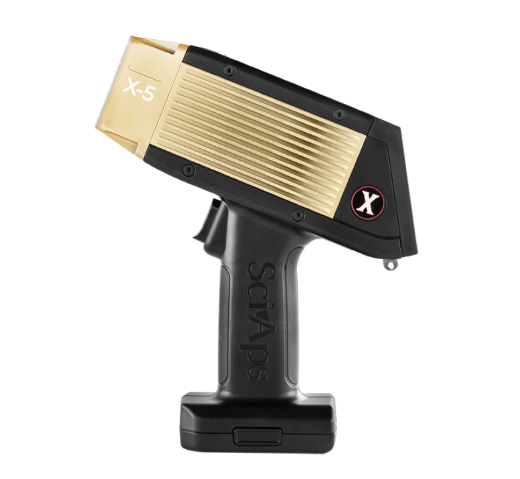
X-5
X-5 Analyzer
X-5 Analyzer
The world’s lightest, smallest, fastest, high-precision family of XRF analyzers, under 3 lbs.
X Series: Speed and precision, beautifully packaged
Our X Series is the world’s lightest, smallest, fastest, high-precision family of XRF analyzers, under 3 lbs. with improved heat dissipation and new user interface. Built on Android OS with Wi-Fi, Bluetooth, GPS and USB, you can manage your data and fleet anywhere, print or email results, and connect to virtually any information management system for seamless test data and reports. And visibility? An integrated camera with video for sample viewing is included with all models, and the latest smartphone display provides easy viewing in all lighting conditions.
- All internal electronics now use less power and operate at higher temperatures—no drift or shutdown.
- Redesigned heat sinking—can now operate continuously up to 110F (43C) ambient temperatures
- New internal circuit boards
- New housing and metal components
- Up-to-date software, user interface, and full recalibration
- Same advanced X-ray tube as other X models
- May be factory calibrated with fundamental parameters, Compton Normalization (EPA Method 6200), or user-defined empirical calibrations.
A Classic, Reimagined
Best-in-class performance and speed
The X-5 is an excellent choice for conducting basic analysis of transition and heavy metals. Designed for users who do not require measurements of Mg, Al, Si, S, or P in alloys or other materials.
For these users, we’ve re-engineered this classic technology and equipped it with more features for many applications at a great value.
Alloy, Scrap: For many NDT/PMI jobs that require verification of low alloy, Cr/Mo steels, stainless and corrosion resistant alloys, the X-5 often delivers excellent performance. Alloy applications include sorting stainless steels, high temp alloys and red metals.
And more: The X-5 is also available for precious metals, RoHS, soil, mining, car catalysts, industrial lead paint and other user-customizable applications.
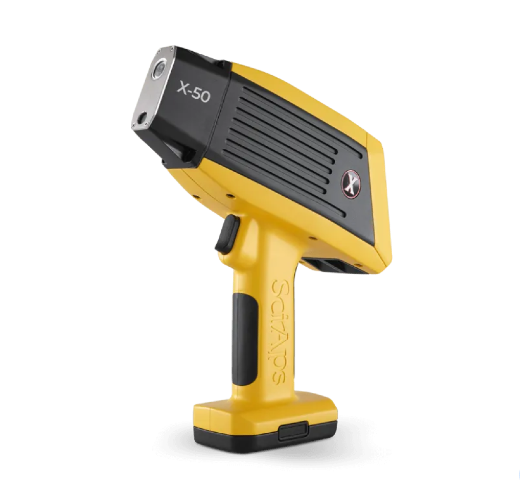
X-50
X-50 XRF Analyzer
X-50 XRF Analyzer
The "classic" model for many applications at a great value.
The totally reengineered X-50 is the highest performing XRF on the market that features a cost effective SDD detector. A little beefier than SciAps sleeker models, this value-priced XRF still offers best-in-class analytical performance and speed for its detector platform, operating at rates 2X or higher than other brands. SciAps powerful, miniaturized X-ray tube combined with highly advanced internal geometry yields fast, precise results.
The X-50 is great for basic analysis of transition and heavy metals. For those who don’t need to measure Mg, Al, Si, S, or P, it’s the perfect choice. We’ve reengineered the classic detector technology with a new internal circuit board, new housing and metal components, up-to-date software and user interface, and full recalibration. And we’ve equipped it with more features, such as a built-in, high-resolution camera for sample viewing and a macro-camera for photo-documentation or 2D/3D barcode reading and storage.
- X-Ray Tube: 40 kV, Rh anode (alloy) or 50kV anode (Geochem, Soil, others)
- Detector Rate: 7 mm2 SDD, silicon drift detector, (active area), 170 eV resolution FWHM at 5.95 Mn K-alpha line
Standard Element Package
The standard element package for the X-50 is shown in the table below. We add or substitute elements frequently for specific applications.
| Application | Beam 1 (40 kV) | Beam 2 (10 kV) | Beam 3 (50 kV) |
|---|---|---|---|
| Mining | Ti, V, Cr, Mn, Fe, Co, Ni, Cu, Zn, As, Se, Sr, Rb, Zr, Nb, Mo, W, Ta, Au, Hg, Pb, Bi, U, Ag, Sn, Sb | S, K, Ca | N/A |
| Soil | Ti, V, Cr, Mn, Fe, Co, Ni, Cu, Zn, As, Se, Sr, Rb, Zr, Mo, W, Tl, Hg, Pb, Bi, Ag, Cd, Sn, Sb | N/A | N/A |
| Alloy | Ti, V, Cr, Mn, Fe, Co, Ni, Cu, Zn, Se, Y, Zr, Nb, Mo, W, Ta, Hf, Re, Au, Pb, Bi, Ru, Pd, Ag, Cd, Sn, Sb | N/A | N/A |
| Precious Metals | Ti, Cr, Mn, Fe, Co, Ni, Cu, Zn, Ga, W, Au, Ge, Ir, Pt, Au, Pb, Bi, Zr, Mo, Ru, Rh, Pd, Ag, Cd, In, Sn, Sb | N/A | N/A |
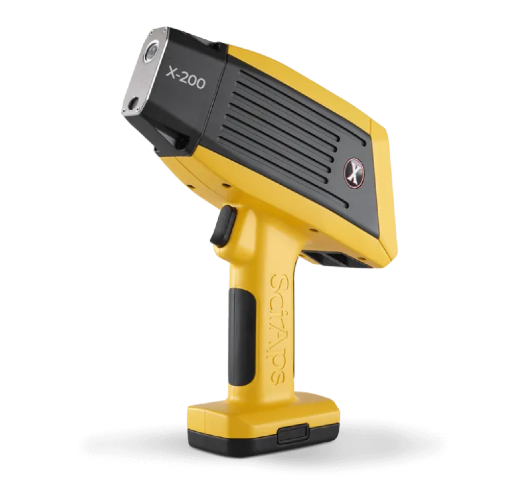
X-200
X-200 XRF Analyzer
X-200 XRF Analyzer
The Workhorse. Our X-200 XRF analyzer is the perfect blend of high performance and attractive price.
The X-200 offers speed and performance comparable or superior to the top end analyzers from other brands. It uses a top-performing SDD combined with highly optimized X-ray tube and detector geometry. The X-200 is rapidly becoming the first choice for scrap processing and non-destructive testing due to speed and analytical performance combined with the lightweight, small form-factor design. It’s fast on every alloy family including aluminum alloys. For geochemical applications, it offers suites of elements for environmental, pathfinder, exploration, and mining. Other available apps include environmental soil, RoHS, Precious Metals, Car Catalysts, Coatings, and SciAps Empirical App for users who want to test other types of materials and generate their own calibration models. Analyzers may be factory calibrated with fundamental parameters, Compton Normalization (EPA Method 6200), or user defined empirical calibrations.
- X-Ray Tube: 40 kV, Rh anode (alloy) or 50 kV Au anode (Geochem, Soil, RoHS, others).
- Detector Rate: 20 mm2 standard SDD and DPP. 125k cps, > 90% live.
Standard Element Package
The standard element package for the X-50 is shown in the table below. We add or substitute elements frequently for specific applications.
| Application | Beam 1 (40 kV) | Beam 2 (10 kV) | Beam 3 (50 kV) |
|---|---|---|---|
| Mining | Ti, V, Cr, Mn, Fe, Co, Ni, Cu, Zn, As, Se, Sr, Rb, Zr, Nb, Mo, W, Ta, Au, Hg, Pb, Bi, U | Mg, Al, Si, P, S, K, Ca | Ag, Sn, Sb, Ba |
| Soil | Geo-Env SoilTi, V, Cr, Mn, Fe, Co, Ni, Cu, Zn, As, Se, Sr, Rb, Zr, Mo, W, Tl, Hg, Pb, Bi | Mg, Al, Si, P, S | Ag, Cd, Sn, Sb, Ba |
| Alloy | Ti, V, Cr, Mn, Fe, Co, Ni, Cu, Zn, Se, Y, Zr, Nb, Mo, W, Ta, Hf, Re, Au, Pb, Bi, Ru, Pd, Ag, Cd, Sn, Sb | Mg, Al, Si, P, S | N/A |
| Precious Metals | Ti, Cr, Mn, Fe, Co, Ni, Cu, Zn, Ga, W, Au, Ge, Ir, Pt, Au, Pb, Bi, Zr, Mo, Ru, Rh, Pd, Ag, Cd, In, Sn, Sb | N/A | N/A |
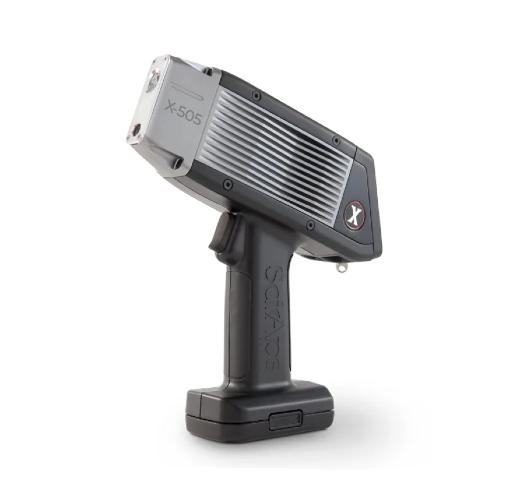
X-505
X-505 XRF Analyzer
X-505 XRF Analyzer
Harmony of performance, ergonomics and price
Our X-505 is the smallest, lightest weight handheld X-ray analyzer ever made. In terms of speed, it is second only to the X-550. Weighing in at 2.8 lbs. with the battery, it delivers the small size, blazing speed and high precision of the X Series in a perfectly balanced device. It’s fast on all alloys, including aluminums. With its state-of-the-art design and excellent heat handling, the X-505 can run all day long, even in the hottest climates, without requiring down time due to overheating.
A brief comparison: X-550 vs. X-505
What’s the difference between the premium X-550 and the workhorse X-505 models? The answer is simple: Speed on low atomic number elements such as Mg, Al, Si, P and S. The X-550 runs at about 3x the X-ray power in the “Beam 2” setting (also known as the low voltage setting) compared to the X-505 or other handheld XRF analyzers. This means the measured intensities from Mg, Al, Si, P and S (plus K, Ca and Cl in other apps) are 3x higher, producing 3x faster measurements. A few common examples are shown below
| Application | X-550 | X-505 | Comment |
|---|---|---|---|
| Measure 0.3% Mg in aluminum alloy | 2 seconds | 7 seconds | For example, sorting Al 356 from 357. |
| Measure 0.1% Si in steels | 6 seconds (1s Beam 1; 5s Beam 2) | 16 seconds (1s Beam 1; 15s Beam 2) | Sulfidic corrosion, requires Si > 0.1% in steels. |
| Measure P and S in steels or stainless | For a given concentration level, about 3x faster than X-505. | Actual test times depend on the specific concentration level of P and S. | |
| Analyze low atomic number elements in mining samples | Measures Mg, Al, Si, P, S, Ca and K 3x faster than X-505. | Measures these elements well, with comparable speeds to other high-end XRFs. | X-550 offers faster test times for major metals, sulfides and contaminant P. |
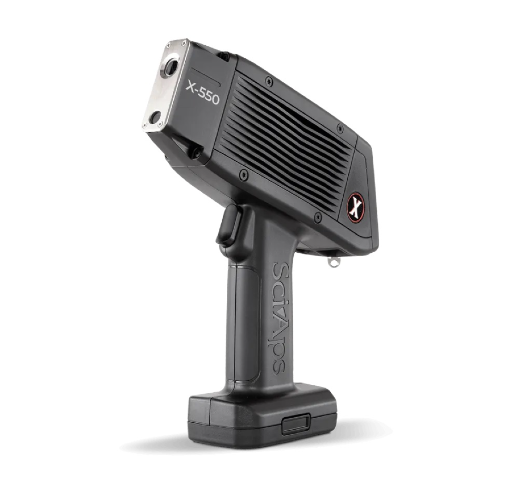
X-550
X-550 XRF Analyzer
X-550 XRF Analyzer
The new standard in XRF
Our X-550 sets a new performance standard for handheld XRF. Weighing 2.98 lbs. (1.3 kg) with the battery, it’s the lightest, fastest, most articulate XRF analyzer ever made. It delivers the small size, blazing speed and high precision of the X Series in a perfectly balanced device. It’s fast on all alloys, including aluminums. The X-550 uses the industry’s most powerful X-ray tube for NDT and recycled materials analysis, operating up to 3x the power in the Beam 2 setting compared to the our X-505 and other handheld XRF analyzers. The unique geometry and tube power optimize performance for low atomic number measurement applications including sulfidic corrosion (low Si), phosphorus and sulfur, and aluminum alloys, as well as for residuals analysis per API 751 and 5L specifications.
A brief comparison: X-550 vs. X-505
What’s the difference between the premium X-550 and the workhorse X-505 models? The answer is simple: Speed on low atomic number elements such as Mg, Al, Si, P and S. The X-550 runs at about 3x the X-ray power in the “Beam 2” setting (also known as the low voltage setting) compared to the X-505 or other handheld XRF analyzers. This means the measured intensities from Mg, Al, Si, P and S (plus K, Ca and Cl in other apps) are 3x higher, producing 3x faster measurements. A few common examples are shown below
| Application | X-550 | X-505 | Comment |
|---|---|---|---|
| Measure 0.3% Mg in aluminum alloy | 2 seconds | 7 seconds | For example, sorting Al 356 from 357. |
| Measure 0.1% Si in steels | 6 seconds (1s Beam 1; 5s Beam 2) | 16 seconds (1s Beam 1; 15s Beam 2) | Sulfidic corrosion, requires Si > 0.1% in steels. |
| Measure P and S in steels or stainless | For a given concentration level, about 3x faster than X-505. | Actual test times depend on the specific concentration level of P and S. | |
| Analyze low atomic number elements in mining samples | Measures Mg, Al, Si, P, S, Ca and K 3x faster than X-505. | Measures these elements well, with comparable speeds to other high-end XRFs. | X-550 offers faster test times for major metals, sulfides and contaminant P. |
X-550 Pb Analyzer
Simply the best lead paint analyzer ever made. No radioactive sources, no isotope replacement.
X-550 Pb employs an X-ray tube that uses an electric current under high voltage to produce X-rays. The latest X-ray tube and detector technology deliver the fastest and most accurate lead paint results.
X-ray eliminates radioactive isotopes. No isotope replacement costs, isotope disposal costs, or regulatory and financial burden for owning and tracking radioactive materials.
The X-550 Pb complements existing applications. Select a rhodium X-ray tube anode or gold X-ray tube anode, depending on whether you also want to perform environmental testing for EPA Priority Pollutant and RCRA metals, or alloy or mining materials analysis. Optional apps include Lead in Soil, Alloy, Geochem (Mining), Empirical, Environmental Metals. Coming soon: Lead in dust wipes and air filters (NIOSH 7702).
X-550 Geochem Analyzer
The next level for Geochemistry
We takes the X-550, the premium performance standard for handheld XRF, to the next level for geochemistry applications
- Integrated fan for high duty cycles in extreme environments
- 50kV X-ray tube and 3- Beam Geochem App for wide element range
- Fast, accurate, resilient

X-555
X-555 XRF Analyzer
X-555 XRF Analyzer
Premium performance begins with the most advanced handheld XRF technology available, led by a 55 kV X-ray tube for extra low detection limits on key elements like Ag, Cd, Sn, Sb, and Ba. Up to three automated beam settings provide optimal performance across the entire periodic table from Mg to U. All in a rugged instrument with state-of-the-art software and outstanding thermal dissipation.
In Use Globally
Mining
Best-in-class light element performance for ultra low detection limits of elements like Mg, Al, Si, P, and S, while also packing enough power to achieve impressive precision on heavy elements like pathfinders Ag, Sn, Sb, and rare earth elements.
Soils
Appropriate filtering to optimize sensitivity — 2x better analysis of cadmium detection than any other XRF! Packs the industry’s most powerful X-ray tube for superior limits of detection—especially for cadmium, silver, tin, antimony and barium. When combined with the new Z-901 Beryllium, get 13 EPA Priority Pollutant Metals. Operators can upgrade the Z-901 Lithium to include lithium, boron, carbon, nitrogen, fluorine, and sodium in their tests, too.
Regulatory Markets
Next-generation connectivity, test data management and reporting for the full range of compliance testing applications, including RoHS, Halogen Free, CPSIA, and lead paint in children’s playgrounds. State-of-the-art data management incorporated into a flexible Android system allows for the greatest customization and data management capabilities.
Electric Vehicle and Strategic Metals
The 55 kV operation, rather than the industry typical 50 kV, delivers higher performance for critical “light” REEs and some “heavy” REEs, making it a superior option for REE analysis globally.
XRF analyzers are the lightest ever made, weighing in at just under 3 lbs. with battery. The durable aerospace-grade aluminum frame passes the Oops Test and the falling-from-a-35-foot-tower test. Redesigned housing with improved heat dissipation allows for high throughput testing that our customers demand. A narrow, slender form factor accesses the toughest test locations, with a 2.7″ display for rear viewing of grade and chemistry.
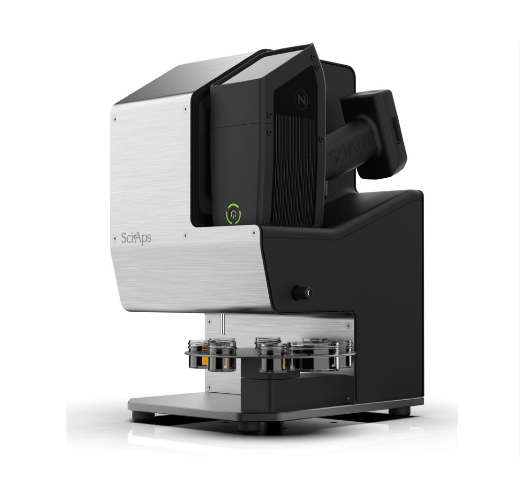
Z-9
Z-9 Liquidator
Z-9 Liquidator
We are proud to announce the first portable LIBS powered Lithium Brines analyzer, the Z-9 Liquidator.
Combined with the Z-903 handheld LIBS, the Z-9 Liquidator provides fast and easy analysis of brines in the field or in the lab. This groundbreaking technique only needs a 1-2 mL of sample per test, with no dilution necessary. The Z-9 Liquidator samples the liquid and atomizes it into a fine mist which is then analyzed by the Z-903 LIBS. Within seconds, the concentration of Li and other key elements are displayed on nearby tablet or PC.
Fast
No more waiting days, weeks or even months for results from complicated lab techniques!
Easy
Simply feed your sample to the Z-9 Liquidator and your brines composition is reported in seconds!
Accurate
Powered by the SciAps Z-903 handheld LIBS analyzer, equipped with factory built lithium brines calibration. Users can also develop a custom calibration via the Profile Builder software to further optimize performance.
Versatile
With a small footprint and light but durable construction - the SciAps Z-9 Liquidator is right at home in the lab, in the plant or even in the field! Transportation is easy for analyzing brines at the well or evaporation ponds.

PowerHouse X
Portable Benchtop XRF
PowerHouse X
The Groundbreaking Portable Benchtop XRF
- First Ever Portable XRF with 80kV X-ray Tube
- Measure Heavy REEs Tb, Dy, Ho, Er, Yb
- Battery Powered, Fully Shielded and Safety Interlocked
REEs in the Field
The world’s dependency on critical rare earth elements (REEs) has never been higher. However, the ability to properly analyze these elements in the field has been underwhelming. Conventional portable XRF, with maximum X-ray tube voltages of 50kV, can measure the light REEs but struggle to measure heavy REEs in any practical way due to inadequate excitation and severe spectral overlaps with common metals such as Fe, Cu, Ni.
PowerHouse is the answer
Utilizing an 80kV miniature X-ray tube, the PowerHouse can efficiently excite the K shell emission lines for both light and heavy REEs. By analyzing these high energy K-lines, the complicated spectral overlaps with common metals are avoided completely, yielding unprecedented limits of detection and better performance than any other portable XRF.
PowerHouse Portable 80 kV XRF for REEs
Heavy REEs: Gd, Tb, Dy, Ho, Er, Yb, Lu
Light REEs: La, Ce, Pr, Nd, Sm, Eu
With multiple excitation parameters, the PowerHouse measures a wide range of elements just like other portable XRFs including transition metals, common pathfinders, and other economically important elements.
Portable, battery powered, and easily transported from site to site. Running on the familiar and intuitive SciAps user interface, the data is easy to acquire, easy to record and easy to share with built in Wi-Fi, Bluetooth, and GPS.

One Box
The ONE BOX
One Box
Both the Z and X handheld analyzers run on the same software platform, operating system, have the same user interface, same battery, and same charger making training and operation a breeze. Get them both when you purchase the ONEBOX package.
Bulk Samples and Microanalysis
The ONE BOX unites established X-ray technology for transition and heavy metals analysis with breakthrough handheld LIBS technology for the lightest of elements (Li, Be, B, C, F, Na, Mg, Al, Si). Sort your “lights” and ferrous lightning fast and accurately with the Z; your stainless, high temps and red metals with the X. Both the X and Z back up each other, so you’re ready for every situation.
